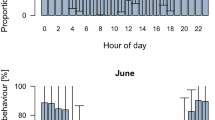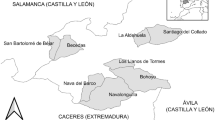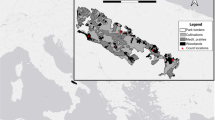Abstract
Wild boar have been increasing in numbers all over Western Europe in the last 30 years. The species is a major pest for agriculture, but it has a high value as a game species, and in Italy, as in several other countries, it is traditionally hunted in drive hunts by hunting teams with several dogs. This hunting method can have disruptive effects on the demography and spatial behaviour of wild boar, especially family groups. We conducted a 2-year study (2003 and 2004) to determine the effects of drive hunt disturbance on the spatial behaviour of wild boar family groups in the Northern Apennines (central Italy). Twenty wild boar belonging to ten family groups were ear tagged with a radio device. We located resting sites daily and used intensive tracking sessions during drive hunts. Three seasons were determined: pre-hunting, hunting and post-hunting. A general pattern of increased spatial instability during the hunting season was shown. Resting ranges were larger, and resting sites were more interspersed. Distances between consecutive resting sites were greater during the hunting season and, especially, on hunting days. The displacement of family groups caused by drive hunts was generally short lived except for those groups that were repeatedly hunted and so abandoned their pre-hunt (native) range. During drive hunts, wild boar showed a moderate tolerance to hunting disturbance, and only family groups which were directly chased by dogs escaped or altered their behaviour. The response of wild boar to hunting disturbance seemed to be highly related to the degree of hunting pressure combined with individual variability. The impact on wild boar behaviour should be reduced, above all by avoiding repeated hunts in the same areas within a short period and by employing well-trained hounds.







Similar content being viewed by others
References
Aubert M, Picard M, Fouquet E, Conde J, Cruciere C, Ferry R, Barrat J, Vedeau F (1994) La peste porcine classique du sanglier en Europe. Ann Med Vet 138:239–247
Bateson P, Bradshaw EL (1997) Physiological effects of hunting red deer (Cervus elaphus). Proc R Soc Lond B 264:1707–1714
Baubet E, Brandt S, Touzeau C (1998) Effet de la chasse sur les stratégies d’occupation de l’espace des sangliers (Sus scrofa). Analyses préliminaires. Gibier Faune Sauvage 15(2):655–658
Boitani L, Mattei L, Nonis D, Corsi F (1994) Spatial and activity patterns of wild boar in Tuscany, Italy. J Mammal 75:600–612. doi:10.2307/1382507
Boscagli G (1987) Brown bear mortality in Central Italy from 1970 to 1984. International conference on Bear Research and Management 7:97–98
Brandt S, Vassant J, Jullien JM (1998) Domaine vital diurne des sangliers en forêt de Châteauvillain-Arc-en-Barrois. Bulletin Mensuel Office National Chasse 234:4–11
Briedermann L (1986) Schwarzwild. VEB Deutscher, Landwirtschaftsverlag
Calenge C, Maillard D, Vassant J, Brandt S (2002) Summer and hunting season home range of wild boar (Sus scrofa) in two habitats in France. Game Wildl Sci 19(4):281–302
Calenge C, Maillard D, Fournier P, Fouque C (2004) Efficiency of spreading maize in the garigues to reduce wild boar (Sus scrofa) damage to Mediterranean vineyards. Eur J Wildl Res 50:112–120
Carnevali L, Pedrotti L, Riga F, Toso S (2009) Ungulates in Italy: Status, distribution, abundance, management and hunting of Ungulate populations in Italy - Report 2001–2005. Biol Cons Fauna, 117, Istituto Nazionale Fauna Selvatica
Cederlund G, Kjellander P (1991) Effects of chasing by hunting dogs on roe deer. In: Csanyi S, Emhaft J (eds) Transactions of the 20th Congress of the International Union of Game Biologists. University of Agricultural Science, Gödöllö, Hungary, August 21–26. pp 363-370
Ciucci P, Boitani L (2008) The Apennine brown bear: a critical review of its status and conservation problems. Ursus 19(2):130–145
Conner MM, White GC, Freddy DJ (2001) Elk movement in response to early-season hunting in northwest Colorado. J Wildl Manage 65(4):926–940
Dardaillon M (1986) Seasonal variations in habitat selection and spatial distribution of wild boar (Sus scrofa) in the Camargue, Southern France. Behav Processes 13:251–286
Dardaillon M (1988) Wild boar social groupings and their seasonal changes in the Camargue, southern France. Z Säugetierkund 53:22–30
Fenati M, Monaco A, Guberti V (2008) Efficiency and safety of xylazine and tiletamine/zolazepam to immobilize captured wild boars (Sus scrofa L. 1758): analysis of field results. Eur J Wildl Res 54(2):269–274. doi:10.1007/s10344-007-0140-0
Festa Bianchet (2003) Exploitative wildlife management as a selective pressure for the life history evolution of large mammals. In: Festa Bianchet M, Apollonio M (eds) Animal behaviour and wildlife conservation. Island Press, Washington, pp 191–208
Franzetti B, Monaco A, Pedrotti L, Toso S (2002) Reproductive biology and potential increments of a wild boar (Sus scrofa) population in northern Appennines (Italy). Abstract in: Abstract volume of 4th International Wild Boar Symposium. Lousa (Portugal)
Fritzemeier J, Teuffert J, Greiser-Wilke I, Staubach C, Schluter H, Moennig V (2000) Epidemiology of classical swine fever in Germany in the 1990s. Vet Microbiol 77(1–2):29–41
Gabor TM, Hellgren EC, Van Den Busche A, Silvy N (1999) Demography, sociospatial behaviour and genetics of feral pigs (Sus scrofa) in a semi-arid environment. J Zool (Lond) 274:311–322
Gaillard JM, Brandt S, Jullien JM (1993) Body weight effect on reproduction of young wild boar (Sus scrofa) females: a comparative analysis. Folia Zoologica 42(3):204–212
Ginsberg JR, Milner-Gulland EJ (1994) Sex-biased harvesting and population dynamics: implications for conservation and sustainable use. Conserv Biol 8:157–166
Hooge PN, Eichenlaub B (2001) Movement 2.0. Alaska Biological Science Center, US Geological Survey, Anchorage, AK, USA
Jeppesen JL (1987) Impact of human disturbance on home range size, movements and activity of red deer (Cervus elaphus) in a Danish environment. Dan Rev Game Biol 13(2):1–38
Jezierski W (2002) Elements of social and spatial organization of wild boar populations. Scientific papers of agricultural university of Poznan. Forestry 5:39–67
Johnson BK, Ager AA, Noyes JH, Cimon N (2004) Elk and mule deer responses to variation in hunting pressure. In: Transaction of the 69th North American Wildlife and Natural Resources Conference, The Wildlife Institute, Spokane, WA, USA, pp 625-640
Jullien JM, Brandt S, Vassant J, Chantecaille S (1991) Des sangliers chassés en battue en forêt demaniale de Châteauvillain-Arc-en-Barrois: leurs «stratégies» pour échapper aux chasseurs et aux chiens. Bull Mens Off Natl Chasse 162:29–36
Kaminski G, Brandt S, Baubet E, Badoin C (2005) Life-history patterns in female wild boars (Sus scrofa): mother–daughter postweaning associations. Can J Zool 83:474–480
Keuling O, Stier N, Roth M (2005) Does hunting affect the spatial utilisation of wild boar Sus scrofa? In: Pohlmeyer K (ed) Extended abstracts of the XXVIIth Congress of the International Union of Game Biologists, Hannover 2005 DSV-Verlag Hamburg, pp 379-380
Keuling O, Stier N, Roth M (2008a) Annual and seasonal space use of different age classes of female wild boar Sus scrofa L. Eur J Wildl Res 54(3):403–412. doi:10.1007/s10344-007-0157-4
Keuling O, Stier N, Roth M (2008b) How does hunting influence activity and spatial usage in wild boar Sus scrofa L.? Eur J Wildl Res 54(4):729–737. doi:10.1007/s10344-008-0204-9
Kilgo JC, Labinsky RF, Fritzen DE (1998) Influences of hunting on the behavior of white-tailed deer: implications for conservation of the Florida panther. Cons Biol 12(6):1359–1364
Kilpatrick HJ, Lima KK (1999) Effects of archery hunting on movement and activity of female white-tailed deer in an urban landscape. Wildl Soc Bull 27(2):433–440
Klein F, Baubet E, Toïgo C, Leduc D, Saint-Andrieux C, Saïd S, Fréchard C, Vallance M (2004) La gestion du sanglier. Des pistes et des outils pour réduire les populations. Office National de la Chasse et de la Faune Sauvage, Saint Benoit
Kowalski C (1985) Etude écoéthologique du sanglier en Camargue. Mise en place de structures de recueil de données et résultats préliminaires. Mémoire de fin d’études E.N.I.T.A.
Kufeld RC, Bowden DC, Shrupp DL (1988) Influence of hunting on movements of female mule deer. J Range Manage 41:70–72
Lemel J, Truvé J, Söderberg B (2003) Variation in ranging and activity behaviour of European wild boar Sus scrofa in Sweden. Wildl Biol 9(1):29–36
Maillard D (1996) Occupation et utilisation de la garrigue et du vignoble mediterraneens par le sanglier (Sus scrofa L.). Thése de doctorat, Universite d’Aix- Marseille III.
Maillard D, Fournier P (1995) Effects of shooting with hounds on size of resting range of wild boar (Sus scrofa L.) groups in mediterranean habitat. In: Macchi E, Mann C, Fogliato D, Durio P (eds) Proceedings of the “2nd International Symphosium on Wild Boar (Sus scrofa) and on Sub-order Suiformes”. IBEX J Mt Ecol, 3:102-107
Martínez M, Rodríquez V, Jones OR, Coulson T, San Miguel A (2005) Different hunting strategies select for different weights in red deer. Biol Lett 1:353–356. doi:10.1098/rsbl.2005.0330
Massei G, Toso S (1993) Biologia e gestione del cinghiale. INFS Documenti tecnici n.5
Massei G, Genov P, Staines BW, Gorman ML (1997) Factors influencing home range and activity of wild boar (Sus scrofa) in a Mediterranean coastal area. J Zool (Lond) 242:411–423
Mauget R (1980) Régulations écologiques, comportamentales et physiologiques (fonction de reproduction), de l’adaptation du Sanglier Sus scrofa L., au milieu. Thèse d’Etat, Université de Tours
Mauget R, Campan R, Spitz F, Dardaillon M, Janeau G, Pepin D. (1984) Synthèse des connaissances actuelles sur la biologie du sanglier, perspectives de recherches. In: Symposium international sur le Sanglier. Toulouse (France), 24-26 avril 1984. Les Colloques de l’INRA 22: 15-50
Meriggi A, Sacchi O (2000) Habitat requirements of wild boars in the northern apenines (N Italy): a multi-level approach. Ital J Zool 68:47–55
Millspaugh JJ, Brundige GC, Gitzen RA, Raedeke KJ (2000) Elk and hunter space-use sharing in South Dakota. J Wildl Manage 64(4):994–1003
Milner JM, Nilsen EB, Andreassen HP (2007) Demographic side effects of selective hunting in ungulates and carnivores. Cons Biol 21(1):36–47
Monaco A, Carnevali L (2004) Comparing efficiency between ear tags transmitters vs radio collars in wild boar. In: Abstract volume of 5th International Wild Boar Symposium, Kracow (Poland)
Monaco A, Scillitani L. (2006) Daily home range, movements and activity patterns of Wild boar (Sus scrofa) in northern Apennines (Italy). In: Eleftherios Hadjisterkotis (ed.) Sixth International Symposium on Wild boar (Sus scrofa) and on sub-order Suiformes, Abstracts, Cyprus: p.56
Monaco A, Franzetti B, Pedrotti L, Toso S (2003) Linee guida per la gestione del cinghiale. Ministero Politiche Agricole e Forestali-I.N.F.S.
Pavlov PM, Hone J, Kilgour RJ, Pedersen H (1981) Predation by feral pigs on Merino lambs at Nyngan, New South Wales. Aust J Exp Agric Anim Husband 21(113):570–574
Proaktor G, Coulson T, Milner-Gulland EJ (2007) Evolutionary responses to harvesting in ungulates. J Animal Ecology 76:669–678
Rossi S, Fromont E, Artois M, Gauthier D, Hars J, Baubet E, Brandt S,Vassant J, Crucières C and Garin-Bastuji B (2004) Étude d’un réservoir sauvage : dynamique de deux infections chez le sanglier (Sus scrofa). In: Rapport Scientifique ONCFS 2004, pp 76-80
Root BG, Fritzell EK, Giessman NF (1988) Effects of intensive hunting on white tailed deer movement. Wildl Soc Bull 16:145–151
Saez-Royuela C, Telleria JL (1986) The increased population of wild boar (Sus scrofa L.) in Europe. Mammal Rev 16:97–101
Schley L, Roper T (2003) Diet of wild boar Sus scrofa in Western Europe, with particular reference to consumption of agricultural crops. Mammal Rev 33(1):43–56
Scillitani L (2006) Comportamento spaziale e attività di una popolazione di cinghiale (Sus scrofa L., 1758) in un’area sottoposta a prelievo venatorio. Tesi di laurea in Scienze Biologiche, Università degli Studi di Bologna
Servanty S (2007) Dynamique d’une population chassèe de sangliers (Sus scrofa scrofa) en milieu forestestier. Thése de doctorat, Universitè Claude Bernard Lyon1
Servanty S, Gaillard JM, Allaine D, Brandt S, Baubet E (2007) Litter size and fetal sex ratio adjustment in a highly polytocous species: the wild boar. Behav Ecol 18:427–432
Singer FJ, Otto D, Tipton A, Hable C (1981) Home ranges, movements and habitat use of European wild boar in Tennessee. J Wildl Manage 45(2):343–353
Sodeikat G, Pohlmeyer K (2003) Escape movements of family groups of wild boar Sus scrofa influenced by drive hunts in Lower Saxony, Germany. Wildl Biol 9(Suppl 1):43–49
Sodeikat G, Pohlmeyer K (2007) Impact of drive hunts on daytime resting site areas of wild boar family groups (Sus scrofa L). Wildl Biol Pract 3:28–38. doi:10.2461/wbp. 2007.3.4
Sutherland WJ, Gill JA (2001) The role of behaviour in studying sustainable exploitation. In: Reynolds JD, Mace GM, Redford KH, Robinson JG (eds) Conservation of exploited species. Cambridge University Press, Cambridge, pp 259–280
Swenson JE (1982) Effects of hunting on habitat use by mule deer on mixed-grass prairie in Montana. Wildl Soc Bull 10(2):115–120
Teillaud P (1986) La vie sociale chez le sanglier: co-émergence collectivité-individualité. Cah Ethol Appl 6:157–184
Toïgo C, Servanty S, Gaillard JM, Brandt S, Baubet E (2008) Disentangling natural from hunting mortality in an intensively hunted wild boar population. J Wildl Manage 72(7):1532–1539. doi:10.2193/2007-378
Tolon V, Baubet E, Gaulard P, Pasquier JJ, Hebeisen C, Fischer C, Dobremez JF (2008) Comportement du sanglier en réponse à la pression de chasse. Influence des "réserves" sur son occupation de l’espace. In: Klein F, Guibert B, Baubet E (ed.) Modalités de gestion du sanglier. Actes du colloque tenu à Reims (Marne) les 1er et 2 mars 2007, Paris: F.N.C.,O.N.C.F.S. pp: 172-181
Tsachalidis E, Hadjisterkotis E (2008) Wild boar hunting and socioeconomic trends in Northern Greece, 1993–2002. Eur J Wildl Res 54:643–649. doi:10.1007/s10344-008-0190-y
Tuytten FAM, McDonald D (2000) Consequences of social perturbation for wildlife management and conservation. In: Gosling LM, Sutherland WJ (eds) Behaviour and conservation. Cambridge University Press, Cambridge, pp 315–329
Vassant J, Brandt S, Jullien JM (1992) Des sangliers encore plus sédentaires qu’il était imaginable de le croire. Bull Mens Office Natl Chasse 128:22–26
Vercauteren KC, Hyngstrom SE (1998) Effects of agricultural activities and hunting on home ranges of female white-tailed deer. J Wildl Manage 62(1):280–285
Vieira MEP, Conner MM, White GC, Freddy DJ (2003) Effects of archery hunter numbers and opening dates on elk movement. J Wildl Manage 67(4):717–728
Wood GW, Brenneman RE (1980) Feral hog movements and habitat use in South Carolina. J Wildl Manage 44:420–427
Acknowledgements
This study was funded by the Emilia Romagna Region, Bologna Province, and hunting districts (A.T.C.) BO3 and ATC BO4. We thank the owner and the staff of the “Cà Domenicali” hunting reserve, in particular the Maccaferri and Mongardi families, for their collaboration and logistical help. We also thank all the hunting teams which cooperated with us. We are grateful to Massimo Fenati, Andrea Scappi, Lucilla Carnevali, Paola Aragno, Giulia Serrao, Anna Franchina, Alice Frateschi and Daria Malagigi for their collaboration during the fieldwork and to all the personnel of INFS who helped us with the captures. We wish to thank Stefano Focardi for the valuable advises he gave us and two anonymous reviewers who gave helpful comments on the draft of this paper. The study was performed in compliance with current Italian laws.
Author information
Authors and Affiliations
Corresponding author
Additional information
Communicated by F.-J. Kaup
Rights and permissions
About this article
Cite this article
Scillitani, L., Monaco, A. & Toso, S. Do intensive drive hunts affect wild boar (Sus scrofa) spatial behaviour in Italy? Some evidences and management implications. Eur J Wildl Res 56, 307–318 (2010). https://doi.org/10.1007/s10344-009-0314-z
Received:
Revised:
Accepted:
Published:
Issue Date:
DOI: https://doi.org/10.1007/s10344-009-0314-z




